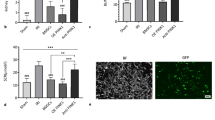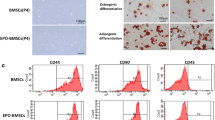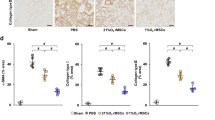Abstract
Renal dysfunction due to ischemia/reperfusion (I/R) injury is a common problem following reno-vascular surgery and kidney transplantation. In the present study, we investigated the protective effects of bone marrow mesenchymal stem cells (BM-MSCs), ischemic preconditioning (IPC), and royal jelly (RJ) administration on kidney I/R injury. Male Balb/c mice (30–35 g) were divided randomly into six groups including sham, I/R, I/R after IPC, I/R pre-treated with 100 mg/kg/day RJ for 20 days (I/R + RJ), treatment with 1 × 106 GFP+ BM-MSCs after I/R induction (I/R + MSCs), and I/R pre-treated with 100 mg/kg/day RJ for 20 days and treated with 1 × 106 GFP+ BM-MSCs after I/R induction (I/R + MSCs/RJ). Ten days before beginning the study, the right kidneys of all the mice were removed. I/R injury was induced by clamping the left renal artery for 45 min followed by reperfusion for 48 h. Blood serum was analyzed for blood urea nitrogen and creatinine levels. The histological patterns and the expression of FADD, BAX, BAD, BCL-2, and miR-24 were also evaluated. The BUN level was reduced in I/R + RJ and I/R + MSCs groups significantly. However, the Cr level was significantly decreased just in the I/R + RJ group. The glomerular injury and expression of apoptosis genes were significantly less in the I/R + RJ and I/R + MSCs/RJ groups. The expression of miR-24 showed reduction in all the treated groups unless IPC. Although the previous studies have shown that IPC protects kidney against I/R injury, we found out MSCs and RJ may have a higher potential to protect the kidney tissue. According to the findings, RJ may be effective to protect the kidney against I/R injury.






Similar content being viewed by others
References
Alexandropoulos D, Bazigos GV, Doulamis IP, Tzani A, Konstantopoulos P, Tragotsalou N, Kondi-Pafiti A, Kotsis T, Arkadopoulos N, Smyrniotis V, Perrea DN (2017) Protective effects of N-acetylcystein and atorvastatin against renal and hepatic injury in a rat model of intestinal ischemia-reperfusion. Biomed Pharmacother 89:673–680
Awad AS, El-Sharif AA (2011) Curcumin immune-mediated and anti-apoptotic mechanisms protect against renal ischemia/reperfusion and distant organ induced injuries. Int Immunopharmacol 11:992–996
Ayupova DA, Singh M, Leonard EC, Basile DP, Lee BS (2009) Expression of the RNA-stabilizing protein HuR in ischemia-reperfusion injury of rat kidney. Am J Physiol Ren Physiol 297:F95–F105
Azarpira N, Ramzi M, Aghdaie MH, Daraie M, Geramizadeh B (2007) Methylenetetrahydrofolate reductase C677T genotypes and clinical outcome following hematopoietic cell transplant. Exp Clin Transplant 5:693–697
Azarpira N, Ashraf MJ, Aghdaie M (2008a) A 10-year old boy with a hard nodule on his forearm. Archives of Clinical Infectious Diseases 2:99–101
Azarpira N, Ramzi M, Aghdaie MH, Darai M, Geramizadeh B (2008b) Interleukin-10 gene polymorphism in bone marrow transplant recipients. Exp Clin Transplant 6:74–79
Azarpira N, Ramzi M, Aghdaie M, Daraie M (2009) Procalcitonin and C-reactive protein serum levels after hematopoietic stem-cell transplant. Exp Clin Transplant 7:115–118
Azarpira N, Malekhosseini SA, Aghdaie MH, Daraie M (2010) CTLA4 CT60 A/G gene polymorphism in liver transplant recipients. Exp Clin Transplant 8:210–213
Azarpira N, Aghdai MH, Nikeghbalian S, Geramizadeh B, Darai M, Esfandiari E, Bahador A, Kazemi K, Al-Abdullah IH, Malek-Hosseini SA (2014) Human islet cell isolation: the initial step in an islet transplanting program in Shiraz, Southern Iran. Exp Clin Transplant 12:139–142
Badet L, Benhamou PY, Wojtusciszyn A, Baertschiger R, Milliat-Guittard L, Kessler L, Penfornis A, Thivolet C, Renard E, Bosco D (2007) Expectations and strategies regarding islet transplantation: metabolic data from the GRAGIL 2 trial. Transplantation 84:89–96
Baeyens L, De Breuck S, Lardon J, Mfopou J, Rooman I, Bouwens L (2005) In vitro generation of insulin-producing beta cells from adult exocrine pancreatic cells. Diabetologia 48:49–57
Bagheri F, Mani A, Tadayyoni A, Firozi F, Nazarinia MA (2013) The prevalence of psychiatric symptoms in the patients with Behcet's disease in Shiraz, Southwest of Iran. J Mood Disorders 3:28
Baharvand H, Jafary H, Massumi M, Ashtiani SK (2006) Generation of insulin-secreting cells from human embryonic stem cells. Develop Growth Differ 48:323–332
Bai C, Li X, Gao Y, Wang K, Fan Y, Zhang S, Ma Y, Guan W (2016) Role of microRNA-21 in the formation of insulin-producing cells from pancreatic progenitor cells. Biochim Biophys Acta 1859:280–293
Banerjee M, Virtanen I, Palgi J, Korsgren O, Otonkoski T (2012) Proliferation and plasticity of human beta cells on physiologically occurring laminin isoforms. Mol Cell Endocrinol 355:78–86
Banting F, Best CH, Collip JB, Campbell WR, Fletcher AA (1922) Pancreatic extracts in the treatment of diabetes mellitus. Can Med Assoc J 12:141
Baranski JD, Chaturvedi RR, Stevens KR, Eyckmans J, Carvalho B, Solorzano RD, Yang MT, Miller JS, Bhatia SN, Chen CS (2013) Geometric control of vascular networks to enhance engineered tissue integration and function. Proc Natl Acad Sci 110:7586–7591
Barber FA, Hrnack SA, Snyder SJ, Hapa O (2011) Rotator cuff repair healing influenced by platelet-rich plasma construct augmentation. Arthroscopy 27:1029–1035
Barker CF, Frangipane LG, Silvers WK (1977) Islet transplantation in genetically determined diabetes. Ann Surg 186:401–410
Beattie GM, Montgomery AM, Lopez AD, Hao E, Perez B, Just ML, Lakey JR, Hart ME, Hayek A (2002) A novel approach to increase human islet cell mass while preserving β-cell function. Diabetes 51:3435–3439
Cemek M, Aymelek F, Buyukokuroğlu ME, Karaca T, Buyukben A, Yilmaz F (2010) Protective potential of Royal Jelly against carbon tetrachloride induced-toxicity and changes in the serum sialic acid levels. Food Chem Toxicol 48:2827–2832
Cho WY, Choi HM, Lee SY, Kim MG, Kim H-K, Jo S-K (2010) The role of Tregs and CD11c+ macrophages/dendritic cells in ischemic preconditioning of the kidney. Kidney Int 78:981–992
El Morsy EM, Ahmed MAE, Ahmed AAE (2015) Attenuation of renal ischemia/reperfusion injury by açaí extract preconditioning in a rat model. Life Sci 123:35–42
Endre ZH (2011) Renal ischemic preconditioning: finally some good news for prevention of acute kidney injury. Kidney Int 80:796–798
Fan R, Yu T, Lin J-L, Ren G-D, Li Y, Liao X-X, Huang Z-T, Jiang C-H (2016) Remote ischemic preconditioning improves post resuscitation cerebral function via overexpressing neuroglobin after cardiac arrest in rats. Brain Res 1648:345–355
Fontana R, Mendes MA, De Souza BM, Konno K, Cesar LMM, Malaspina O, Palma MS (2004) Jelleines: a family of antimicrobial peptides from the Royal Jelly of honeybees (Apis mellifera). Peptides 25:919–928
Godwin JG, Ge X, Stephan K, Jurisch A, Tullius SG, Iacomini J (2010) Identification of a microRNA signature of renal ischemia reperfusion injury. Proc Natl Acad Sci 107:14339–14344
Hernandez DJ, Roberts WB, Miles-Thomas J, Magheli A, Saha S, Schaeffer EM, Racusen LC, Allaf ME (2008) Can ischemic preconditioning ameliorate renal ischemia-reperfusion injury in a single-kidney porcine model? J Endourol 22:2531–2536
Herrero F, Morales D, Baamonde C, Salas E, Berrazueta JR, Casanova D (2006) Ischemic preconditioning and kidney transplantation: in vivo nitric oxide monitoring in a rat ischemia-reperfusion experimental model. Transplant Proc 38:2600–2602
Joo JD, Kim M, D’agati VD, Lee HT (2006) Ischemic preconditioning provides both acute and delayed protection against renal ischemia and reperfusion injury in mice. J Am Soc Nephrol 17:3115–3123
Kapitsinou PP, Haase VH (2015) Molecular mechanisms of ischemic preconditioning in the kidney. Am J Physiol Ren Physiol 309:F821–F834
Karadeniz A, Simsek N, Karakus E, Yildirim S, Kara A, Can I, Kisa F, Emre H, Turkeli M (2011) Royal jelly modulates oxidative stress and apoptosis in liver and kidneys of rats treated with cisplatin. Oxidative Med Cell Longev 2011:1–10
Kinsey GR, Huang L, Vergis AL, Li L, Okusa MD (2010) Regulatory T cells contribute to the protective effect of ischemic preconditioning in the kidney. Kidney Int 77:771–780
Kohno K, Okamoto I, Norie A, Iwaki K, Ikeda M, Kurimoto M (2004) Royal jelly inhibits the production of proinflammatory cytokines by activated macrophages. Biosci Biotechnol Biochem 68:138–145
Kolocassides KG, Galiñanes M, Hearse DJ (1996) Ischemic preconditioning, cardioplegia or both? Differing approaches to myocardial and vascular protection. J Mol Cell Cardiol 28:623–634
Lee HT, Emala CW (2000) Protective effects of renal ischemic preconditioning and adenosine pretreatment: role of A 1 and A 3 receptors. Am J Physiol Ren Physiol 278:F380–F387
Lorenzen JM, Kaucsar T, Schauerte C, Schmitt R, Rong S, Hubner A, Scherf K, Fiedler J, Martino F, Kumarswamy R (2014) MicroRNA-24 antagonism prevents renal ischemia reperfusion injury. J Am Soc Nephrol 25:2717–2729
Mahfoudh-Boussaid A, Zaouali MA, Hadj-Ayed K, Miled A-H, Saidane-Mosbahi D, Rosello-Catafau J, Abdennebi HB (2012) Ischemic preconditioning reduces endoplasmic reticulum stress and upregulates hypoxia inducible factor-1α in ischemic kidney: the role of nitric oxide. J Biomed Sci 19:7
Nagai T, Inoue R (2004) Preparation and the functional properties of water extract and alkaline extract of royal jelly. Food Chem 84:181–186
Najafi G, Nejati V, Shalizar Jalali A, Zahmatkesh E (2014) Protective role of royal jelly in oxymetholone-induced oxidative injury in mouse testis. Iran J Toxicol 8:1073–1080
Nowak G, Takacsova-Bakajsova D, Megyesi J (2017) Deletion of protein kinase C-ε attenuates mitochondrial dysfunction and ameliorates ischemic renal injury. Am J Physiol Ren Physiol 312:F109–F120
Okamoto I, Taniguchi Y, Kunikata T, Kohno K, Iwaki K, Ikeda M, Kurimoto M (2003) Major royal jelly protein 3 modulates immune responses in vitro and in vivo. Life Sci 73:2029–2045
Park KM, Byun J-Y, Kramers C, Kim JI, Huang PL, Bonventre JV (2003) Inducible nitric-oxide synthase is an important contributor to prolonged protective effects of ischemic preconditioning in the mouse kidney. J Biol Chem 278:27256–27266
Sadis C, Teske G, Stokman G, Kubjak C, Claessen N, Moore F, Loi P, Diallo B, Barvais L, Goldman M (2007) Nicotine protects kidney from renal ischemia/reperfusion injury through the cholinergic anti-inflammatory pathway. PLoS One 2:e469
Silici S, Ekmekcioglu O, Kanbur M, Deniz K (2011) The protective effect of royal jelly against cisplatin-induced renal oxidative stress in rats. World J Urol 29:127–132
Supavekin S, Zhang W, Kucherlapati R, Kaskel FJ, Moore LC, Devarajan P (2003) Differential gene expression following early renal ischemia/reperfusion. Kidney Int 63:1714–1724
Tian W, Liu Y, Zhang B, Dai X, Li G, Li X, Zhang Z, Du C, Wang H (2015) Infusion of mesenchymal stem cells protects lung transplants from cold ischemia-reperfusion injury in mice. Lung 193:85–95
Torras J, Herrero-Fresneda I, Lloberas N, Riera M, Cruzado JM, Grinyó JM (2002) Promising effects of ischemic preconditioning in renal transplantation. Kidney Int 61:2218–2227
Viuda-Martos M, Ruiz-Navajas Y, Fernández-López J, Pérez-Álvarez JA (2008) Functional properties of honey, propolis, and royal jelly. J Food Sci 73:117–124
Vucevic D, Melliou E, Vasilijic S, Gasic S, Ivanovski P, Chinou I, Colic M (2007) Fatty acids isolated from royal jelly modulate dendritic cell-mediated immune response in vitro. Int Immunopharmacol 7:1211–1220
Yanagita M, Kojima Y, Mori K, Yamada S, Murakami S (2011) Osteoinductive and anti-inflammatory effect of royal jelly on periodontal ligament cells. Biomed Res 32:285–291
Yoon YE, Lee KS, Choi KH, Kim KH, Yang SC, Han WK (2015) Preconditioning strategies for kidney ischemia reperfusion injury: implications of the “time-window” in remote ischemic preconditioning. PLoS One 10:e0124130
Acknowledgements
Our special thanks to Dr. Nasrin Shokrpour for the linguistic editing of this manuscript.
Author information
Authors and Affiliations
Corresponding author
Ethics declarations
Our study was compliance with ethical standards.
Conflict of interest
The authors declare that they have no conflict of interest.
Research involving human participants and/or animals
All procedures performed in studies involving animals were in accordance with the ethical standards of the institution and all applicable institutional guidelines for the care and use of animals were followed.
Informed consent
Humans are not involved in this study.
Rights and permissions
About this article
Cite this article
Didar, G., Delpazir, F., Kaviani, M. et al. Influence of mesenchymal stem cells and royal jelly on kidney damage triggered by ischemia-reperfusion injury: comparison with ischemic preconditioning in an animal model. Comp Clin Pathol 28, 311–320 (2019). https://doi.org/10.1007/s00580-018-2842-y
Received:
Accepted:
Published:
Issue Date:
DOI: https://doi.org/10.1007/s00580-018-2842-y




